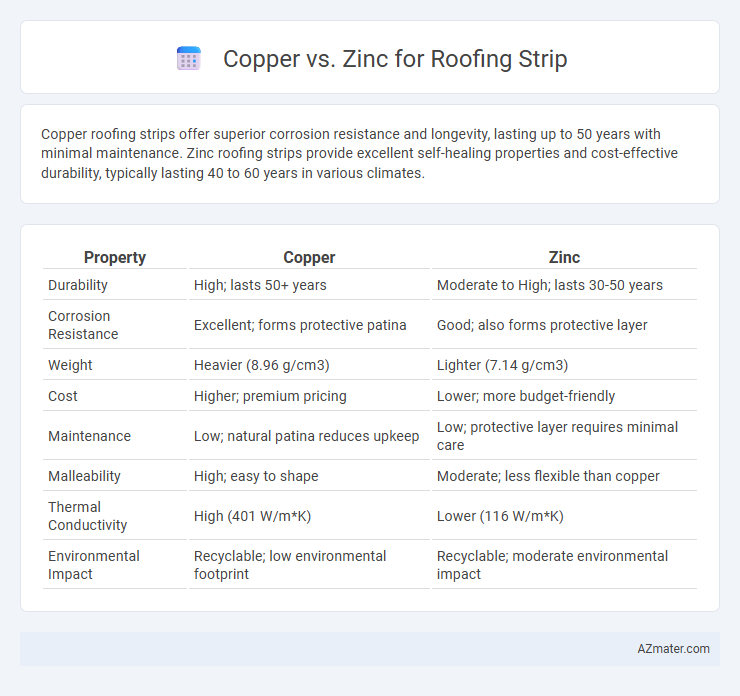Copper roofing strips offer superior corrosion resistance and longevity, lasting up to 50 years with minimal maintenance. Zinc roofing strips provide excellent self-healing properties and cost-effective durability, typically lasting 40 to 60 years in various climates.
Table of Comparison
| Property | Copper | Zinc |
|---|---|---|
| Durability | High; lasts 50+ years | Moderate to High; lasts 30-50 years |
| Corrosion Resistance | Excellent; forms protective patina | Good; also forms protective layer |
| Weight | Heavier (8.96 g/cm3) | Lighter (7.14 g/cm3) |
| Cost | Higher; premium pricing | Lower; more budget-friendly |
| Maintenance | Low; natural patina reduces upkeep | Low; protective layer requires minimal care |
| Malleability | High; easy to shape | Moderate; less flexible than copper |
| Thermal Conductivity | High (401 W/m*K) | Lower (116 W/m*K) |
| Environmental Impact | Recyclable; low environmental footprint | Recyclable; moderate environmental impact |
Introduction to Roofing Strips: Copper vs Zinc
Roofing strips are essential components that provide durability and weather resistance to roofs, with copper and zinc being two prominent materials used for their superior corrosion resistance and aesthetic appeal. Copper roofing strips offer exceptional longevity, often exceeding 50 years, and develop a distinctive patina that enhances visual character while requiring minimal maintenance. Zinc roofing strips balance durability with environmental sustainability, featuring self-healing properties that reduce corrosion and extending roof life up to 80 years in optimal conditions.
Material Properties: Copper and Zinc Compared
Copper roofing strips exhibit excellent corrosion resistance, outstanding durability with a lifespan exceeding 50 years, and superior malleability for easy installation and complex shapes. Zinc roofing strips offer natural self-healing properties through patination, moderate strength with a lifespan of 40 to 60 years, and excellent resistance to environmental pollutants and oxidation. Both metals provide thermal expansion compatibility and low maintenance, but copper tends to develop a distinct green patina while zinc forms a protective grayish layer over time.
Durability and Longevity of Copper and Zinc Strips
Copper roofing strips offer exceptional durability with a lifespan often exceeding 70 years due to their resistance to corrosion and ability to develop a protective patina over time. Zinc strips provide impressive longevity as well, typically lasting around 50 to 80 years, benefiting from self-healing properties that repair scratches and minimize maintenance. Both materials excel in harsh weather conditions, but copper generally outperforms zinc in durability under extreme environments.
Cost Analysis: Copper vs Zinc for Roofing
Copper roofing strips generally cost between $15 to $30 per square foot, reflecting their premium durability and long lifespan. Zinc roofing strips are typically priced lower, around $10 to $20 per square foot, offering a more budget-friendly option with excellent corrosion resistance. While copper demands a higher initial investment, its minimal maintenance and longevity can result in lower total lifecycle costs compared to zinc.
Aesthetic Appeal and Design Flexibility
Copper roofing strips exhibit a rich, warm patina that evolves over time, offering unparalleled aesthetic appeal and a timeless elegance in architectural design. Zinc roofing strips provide superior design flexibility due to their malleability, allowing for intricate shapes and custom profiles that enhance modern and complex roof structures. Both metals offer durable and visually distinct options, but copper's natural color transformation contrasts with zinc's versatility in achieving sleek, contemporary finishes.
Environmental Impact and Sustainability
Copper roofing strips offer exceptional durability and recyclability, making them a sustainable choice with a lower environmental footprint over their lifespan due to their long service life and 100% recyclability. Zinc roofing strips are highly resistant to corrosion and self-healing, reducing maintenance needs and extending roof longevity while being energy-efficient to produce and fully recyclable. Both materials contribute to sustainable roofing by minimizing resource consumption and waste generation, with copper excelling in durability and zinc in energy-efficient production.
Installation Process: Differences and Challenges
Copper roofing strips require meticulous soldering and specialized tools for seamless joints, making the installation process more labor-intensive and time-consuming compared to zinc. Zinc strips allow for easier folding and shaping due to their malleability, reducing the risk of damage during installation but necessitating skilled craftsmanship to avoid surface scratches. Both materials demand precise flashing techniques and careful expansion allowance; however, copper's higher thermal conductivity can increase the potential for thermal movement challenges during installation.
Maintenance Requirements for Copper and Zinc
Copper roofing strips require minimal maintenance due to their natural patina formation, which protects against corrosion and eliminates the need for frequent cleaning or coating. Zinc roofing strips develop a protective layer of zinc carbonate that self-heals minor scratches and reduces maintenance frequency, but may need occasional washing to remove dirt and pollutants. Both metals offer long-lasting durability, with copper typically demanding less upkeep in harsh environments compared to zinc.
Weather Resistance and Performance
Copper roofing strips offer exceptional corrosion resistance and can endure harsh weather conditions for over a century, developing a durable patina that protects the material from further degradation. Zinc roofing strips provide impressive weather resistance through natural self-healing properties, forming a protective layer that repairs minor scratches and extends longevity up to 80 years. Both metals perform well in diverse climates, but copper excels in longevity and resistance to acidic rain, while zinc offers lower maintenance with its self-repairing surface.
Choosing the Right Metal: Practical Considerations
Copper offers exceptional durability and natural corrosion resistance, making it ideal for long-lasting roofing strips in harsh weather conditions. Zinc provides excellent flexibility and self-healing properties, which can reduce maintenance needs and extend roof lifespan. Cost and aesthetic preferences also play crucial roles; copper generally has a higher upfront price but develops a desirable patina over time, while zinc is more affordable and maintains its appearance with minimal aging effects.

Infographic: Copper vs Zinc for Roofing Strip
 azmater.com
azmater.com